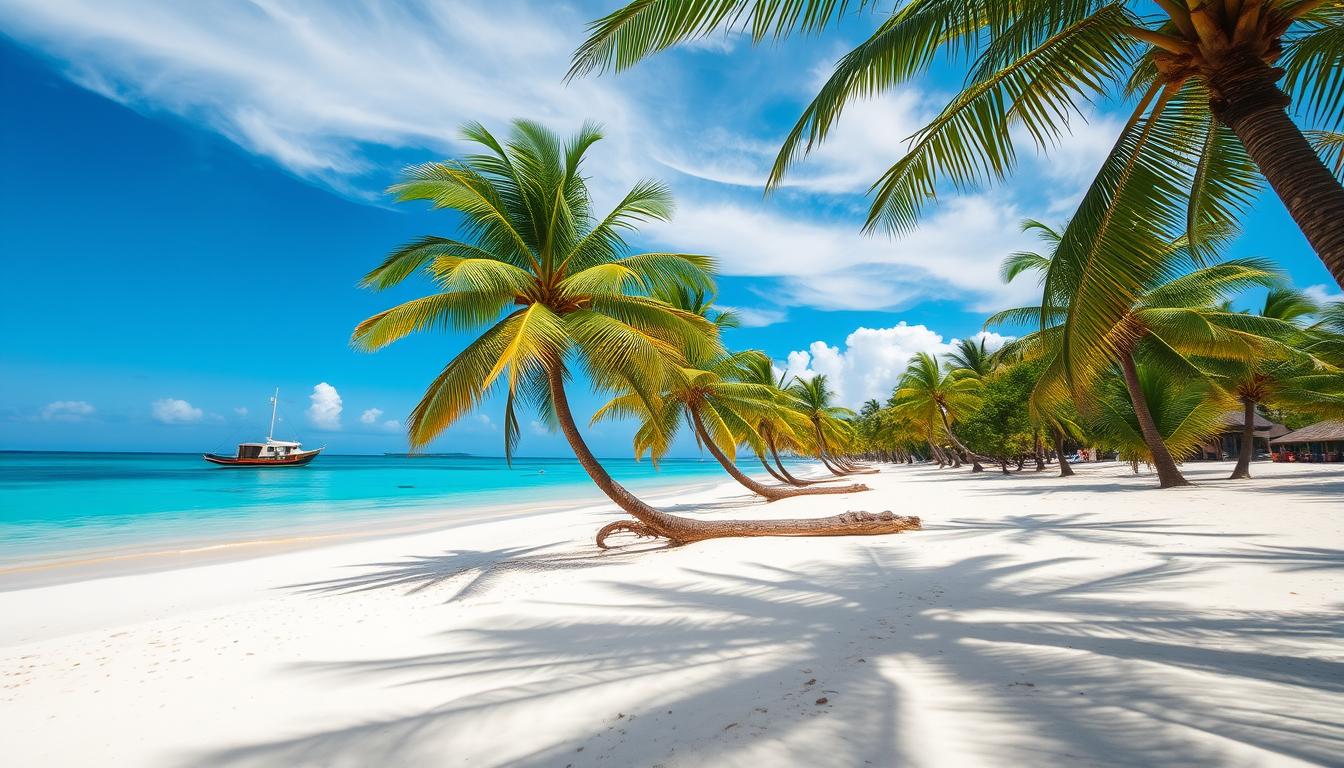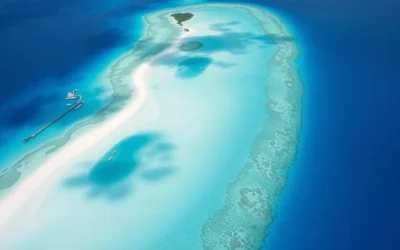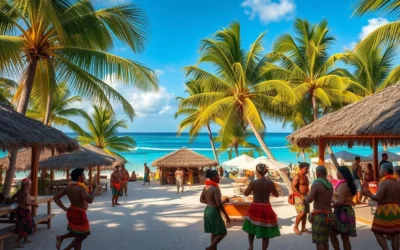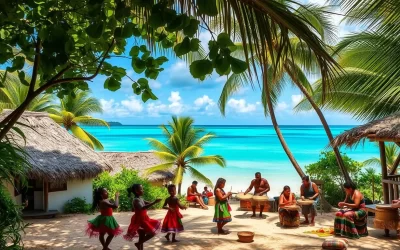✓ Accommodations✓ Flights✓ Rental Cars
Did you know that one of the world’s smallest nations is also one of its most unique? With just 11,000 residents spread across nine islands, this remote paradise offers an escape like no other. Its pristine beaches, turquoise waters, and untouched atoll lifestyle make it a standout destination for those seeking authenticity.
Funafuti, the capital island, is your gateway to this tranquil haven. Home to the country’s only international airport, it’s the perfect starting point for your adventure. However, it’s essential to plan ahead, especially when it comes to money. Cash is king here, as ATMs and credit card terminals are nonexistent.
This guide will walk you through everything you need to know about managing your finances, navigating the islands, and making the most of your trip. Ready to explore? Let’s dive in!
Getting to Know Tuvalu
Nestled in the heart of the Pacific, this hidden gem offers a glimpse into a world untouched by time. Its history, culture, and lifestyle are as captivating as its natural beauty.
A Brief History and Culture
The story of this destination begins with early settlers from Tonga, who arrived centuries ago. Their influence laid the foundation for a unique cultural identity. European navigators later arrived, bringing with them new ideas and practices.
Missionary work in the 19th century played a significant role in shaping the local culture. The blend of traditional beliefs and Christian values is still evident today. In 1978, the islands gained independence, marking a new chapter in their history.
“The islands’ history is a testament to resilience and adaptation, offering a rich tapestry of traditions.”
Discovering the Unique Atoll Lifestyle
Life here revolves around the atolls, which shape daily routines and community events. The close-knit communities thrive on cooperation and shared traditions. Traditional dances, crafts, and social customs are integral to the local way of life.
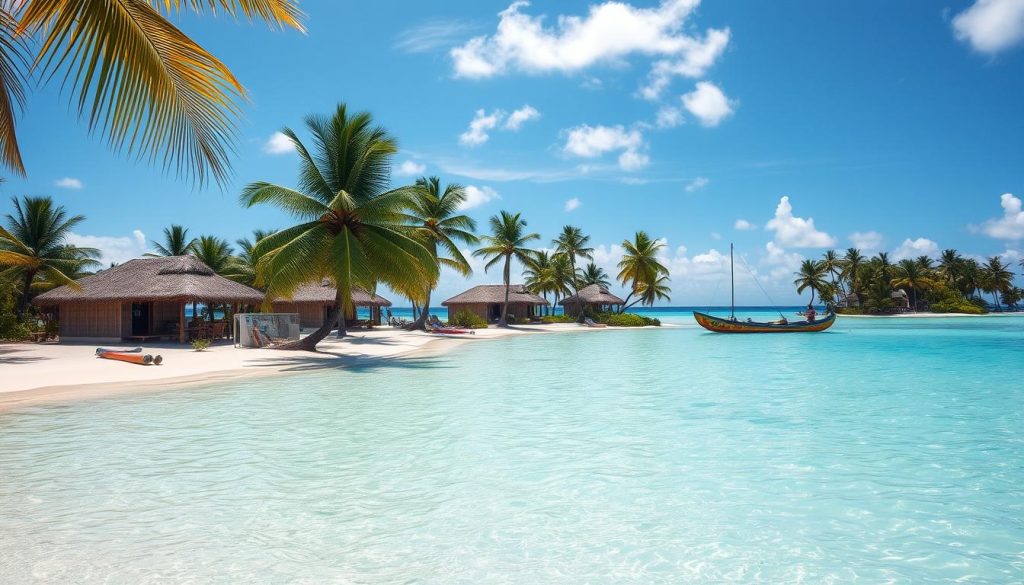
Visiting this destination allows you to step away from the modern hustle and embrace a laid-back island life. It’s a chance to connect with nature and experience a culture that has remained authentic over time.
| Key Cultural Aspects | Description |
|---|---|
| Traditional Dances | Vibrant performances that tell stories of the islands’ history. |
| Local Crafts | Handmade items like woven mats and jewelry, reflecting local artistry. |
| Community Events | Festivals and gatherings that celebrate shared traditions. |
This destination is more than just a place to visit; it’s an opportunity to immerse yourself in a way of life that has stood the test of time. Whether you’re exploring its history or participating in local customs, your travel experience here will be truly unforgettable.
Understanding Tuvalu’s Currency and Payment Systems
Navigating the financial landscape of a remote island nation requires careful planning. The Australian Dollar (AUD) is the official currency here, so you’ll need to exchange your money before arriving. Cash is king, as ATMs are scarce and credit card facilities are limited.

Managing Money While Traveling
When traveling here, it’s essential to carry enough cash for your stay. Exchange your currency at the airport or before your trip to avoid unfavorable rates. Local banks can assist with currency exchange, but their hours may be limited.
The island’s climate and reliance on imported goods mean daily expenses can be higher than expected. Budgeting for meals, transportation, and activities will help you manage your funds effectively.
Limited ATM Availability and Payment Methods
ATMs are rare, and those available may not accept international cards. Plan ahead by withdrawing cash in larger cities or at the airport before heading to the islands. Small businesses and local markets often accept only cash, so keep smaller denominations handy.
“Being prepared with cash ensures you can enjoy your trip without financial stress.”
Understanding the local payment system will make your visit smoother. From transportation to dining, cash is the most reliable way to pay. This approach also supports the local economy and helps you connect with the island’s way of life.
Essential Travel Information and Practical Tips
Planning a trip to a remote island nation requires more than just packing your bags. Understanding the logistics of travel, from visas to transportation, ensures a smooth and enjoyable experience. Here’s what you need to know before you go.
Visa, International Airport, and Transportation
Before you set off, check the visa requirements. Most travelers need a visa, which can be obtained on arrival. Ensure your passport is valid for at least six months beyond your departure date. Customs officials may also ask for proof of sufficient funds and a return ticket.
Funafuti International Airport is your gateway to this Pacific nation. It’s not just an air hub but also a social gathering spot when flights aren’t operating. The airport’s dual role reflects the close-knit community spirit of the islands.

Transportation options are limited but functional. Taxis and scooters are the primary ways to get around. For island hopping, scheduled boat trips are available. Keep in mind that the australian dollar is the official currency, so cash is essential for payments.
Safety, Connectivity, and Health Precautions
Safety is a priority when traveling to remote destinations. While the islands are generally safe, it’s wise to take precautions. Avoid walking alone at night and keep your belongings secure. Medical facilities are limited, so consider travel insurance that covers evacuation.
Health-wise, ensure you’re up-to-date on vaccinations. Drink bottled or treated water to avoid waterborne illnesses. Local advice on bug bites and minor injuries can also be helpful during your stay.
Connectivity is another factor to consider. Internet speeds are unreliable, so plan your communications accordingly. If you rely on a card for emergencies, note that ATMs are scarce, and credit card facilities are limited. Always carry cash in smaller denominations.
“Preparation is key to enjoying a seamless travel experience in this unique nation.”
By understanding these practical tips, you’ll be ready to explore this remote paradise with confidence. From the international airport to local transportation, every detail matters in making your trip unforgettable.
Exploring Funafuti and the Outer Islands
Funafuti serves as the gateway to a world of untouched beauty and adventure. This capital island is not just a starting point but a destination in itself, offering a mix of natural wonders and cultural experiences. From here, you can explore the outer islands, each with its own unique charm.
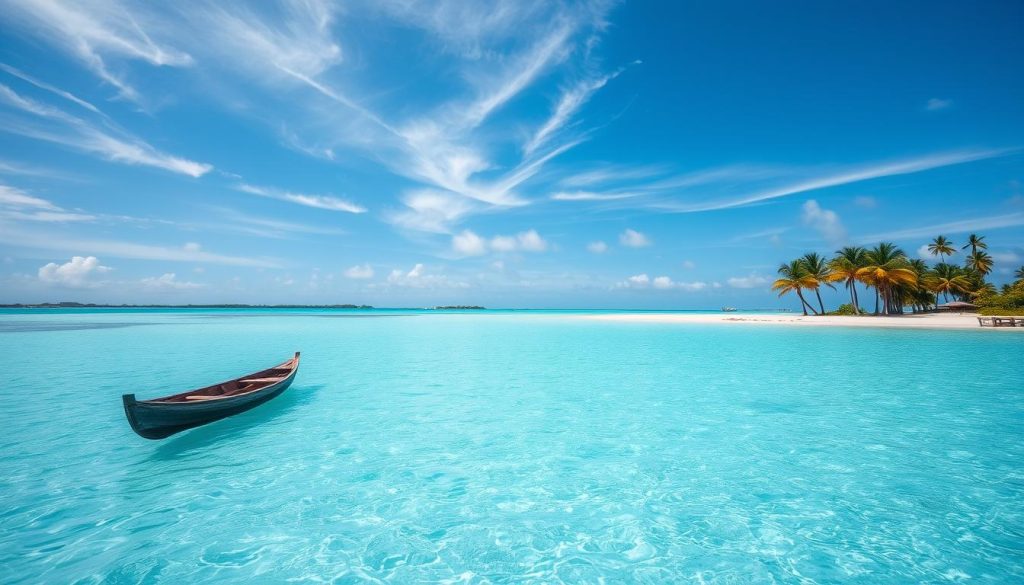
Must-Visit Attractions and Island Hopping Adventures
One of the highlights of your trip will be island hopping. The outer islands are a paradise for nature lovers. Snorkeling in the pristine reefs is a must-do activity. The crystal-clear waters are teeming with colorful marine life, making it an unforgettable experience.
History buffs will enjoy visiting World War II sites scattered across the islands. These remnants of the past offer a glimpse into the region’s historical significance. Don’t miss the chance to witness traditional dance performances, which are a vibrant part of the local culture.
Finding the Best Hotels and Local Accommodations
Accommodation options range from comfortable hotels to charming guesthouses. The Funafuti Lagoon Hotel is a popular choice, offering stunning views and easy access to the lagoon. For a more intimate experience, consider staying in locally-run guesthouses or camping on the outer islands.
Camping allows you to fully immerse yourself in the natural beauty of the islands. Whether you choose a hotel or a campsite, ensure you book in advance, especially during the best time visit season, which runs from May to October.
“Exploring the outer islands is a chance to connect with nature and experience a way of life that has remained unchanged for generations.”
Planning your visit carefully will help you make the most of your time. From snorkeling to cultural events, every moment here is an opportunity to create lasting memories.
Best Time to Visit and Weather Considerations
Timing your visit to this remote paradise can make all the difference in your experience. The best time to explore this destination is during the dry season, from April to October. During these months, you’ll enjoy warm temperatures averaging 84°F (29°C) during the day and 82°F (28°C) at night. The water temperature stays around 86°F (30°C), perfect for snorkeling and swimming.
In contrast, the rainy season runs from November to February, bringing higher humidity and frequent downpours. Cyclone season overlaps from November to April, which can disrupt travel plans. If you’re planning a trip during this period, keep an eye on weather forecasts and pack accordingly.
Seasonal Climate and Rainy Season Tips
The dry season offers ideal conditions for outdoor activities like hiking, island hopping, and exploring the country’s natural beauty. With fewer rainy days, you’ll have more opportunities to enjoy the outdoors. However, the wet season has its charm, with lush landscapes and fewer tourists.
Here are some tips to make the most of your time visit:
- Pack lightweight, breathable clothing for the tropical heat.
- Bring waterproof gear and sturdy shoes for rainy days.
- Plan indoor activities as backups during wet weather.
Choosing the right best time to visit ensures you can fully experience the island’s beauty without weather-related disruptions. Whether you’re snorkeling in crystal-clear waters or hiking through lush trails, timing is everything.
“Planning your trip around the seasons ensures a smoother and more enjoyable adventure.”
By understanding the seasonal patterns, you’ll be well-prepared for your journey. From packing essentials to activity planning, every detail contributes to a memorable trip.
Local Experiences and Cultural Highlights
Immerse yourself in the vibrant traditions and close-knit community life of this Pacific paradise. From traditional dances to seasonal festivals, every moment here offers a glimpse into a culture shaped by centuries of history and a strong sense of community.
Traditional Dances and Community Events
One of the most captivating aspects of your stay will be the traditional dances. These performances are more than just entertainment; they tell stories of the islands’ history and heritage. Each movement and rhythm reflects the spirit of the people, making it a must-see experience.
Community events are another highlight. Whether it’s a seasonal festival or a local gathering, these occasions bring everyone together. You’ll witness the warmth and hospitality of the locals, who are always eager to share their culture with visitors.
Seasonal Festivals and Cultural Immersion
Plan your visit around the seasonal festivals to fully experience the local culture. These events often feature traditional music, dance, and crafts, offering a real taste of life on the atoll. Each month brings something unique, from harvest celebrations to religious observances.
Here are some tips to make the most of your cultural experience:
- Participate in local dances and workshops to connect with the community.
- Attend seasonal festivals to see traditional art and performances.
- Engage respectfully with locals, showing appreciation for their way of life.
“Cultural immersion is the key to understanding the heart and soul of this destination.”
By embracing these experiences, you’ll gain a deeper appreciation for the area’s rich traditions. Whether you’re dancing under the stars or sharing a meal with locals, every moment will leave a lasting impression.
Tuvalu: Ultimate Travelers Guide to Currencies & Payments – Insider Tips
Managing your finances in a remote destination requires insider knowledge and preparation. This section provides practical advice to help you navigate the cash-based economy and make the most of your trip.
Smart Money Management and Budgeting Advice
Cash is essential here, so plan ahead. Exchange your currency at major airports or banks to get the best rate. Local banks may have limited hours, so it’s wise to carry enough cash for your entire stay.
Budgeting is crucial, as daily expenses can vary. Meals, transportation, and activities may cost more than expected due to the island’s reliance on imports. Keep smaller denominations handy for local markets and small businesses.
ATMs are scarce, and the ones available may not accept international cards. Withdraw cash in larger cities or at the airport before heading to the islands. This ensures you’re prepared for any situation.
“Carrying cash is not just practical; it’s a way to connect with the local way of life.”
Leveraging Local Insights for an Authentic Experience
Local insights can enhance your trip significantly. Ask residents for recommendations on the best places to dine, shop, and explore. This not only saves money but also provides a more authentic experience.
Historical sites from World War II are scattered across the islands. These remnants, including old shipwrecks, offer a glimpse into the region’s past. Exploring these sites adds depth to your journey.
Stay informed about the weather to plan your activities effectively. The dry season is ideal for outdoor adventures, while the wet season offers lush landscapes and fewer tourists.
| Budgeting Tips | Benefits |
|---|---|
| Exchange currency before arrival | Get the best rate and avoid last-minute stress |
| Carry smaller denominations | Easier transactions at local markets |
| Withdraw cash in larger cities | Ensure access to funds in remote areas |
Balancing your budget while accounting for variable expenses like tourism rates and local service fees ensures a stress-free trip. By following these tips, you’ll be well-prepared to enjoy every moment of your adventure.
Conclusion
Exploring this remote destination offers a rare blend of adventure and cultural immersion. From its vibrant marine life to the serene beauty of its outer islands, every moment here is unforgettable. Planning ahead is key, especially when it comes to managing your finances. Remember, cash is essential, as service options like ATMs and card payments are limited.
This destination is more than just a tourist spot; it’s a chance to connect with a community that thrives on tradition and simplicity. Whether you’re snorkeling in crystal-clear waters or learning about local customs, the level of authenticity is unmatched.
Pack your bags, prepare your budget, and get ready for an experience that combines natural beauty, historical intrigue, and warm hospitality. Your journey awaits!
The above is subject to change.
Check back often to TRAVEL.COM for the latest travel tips and deals.
